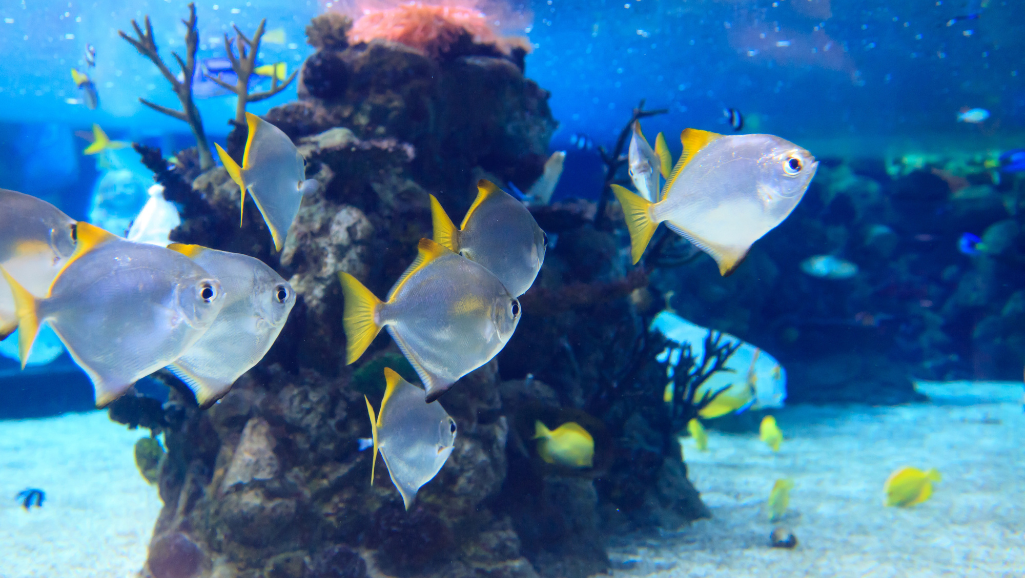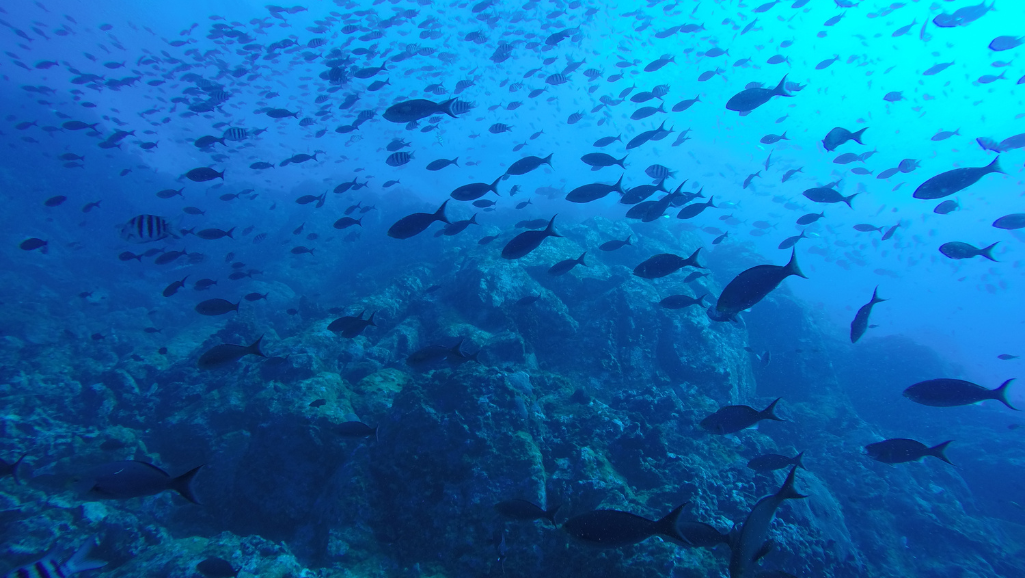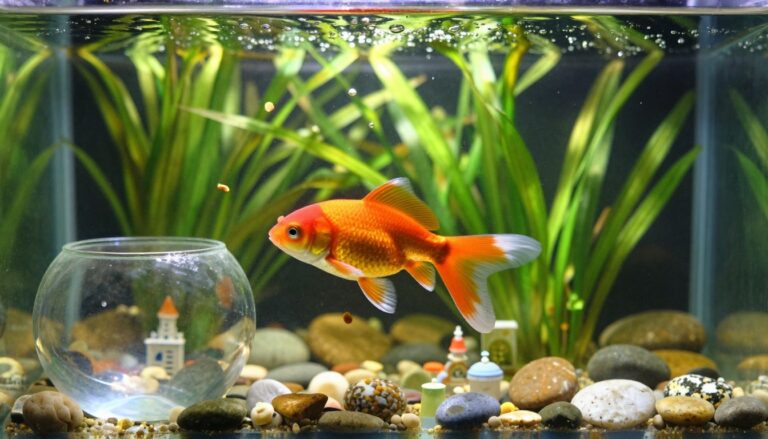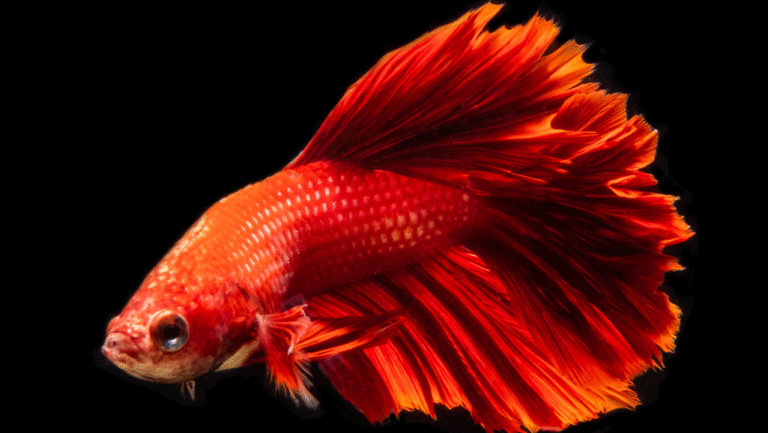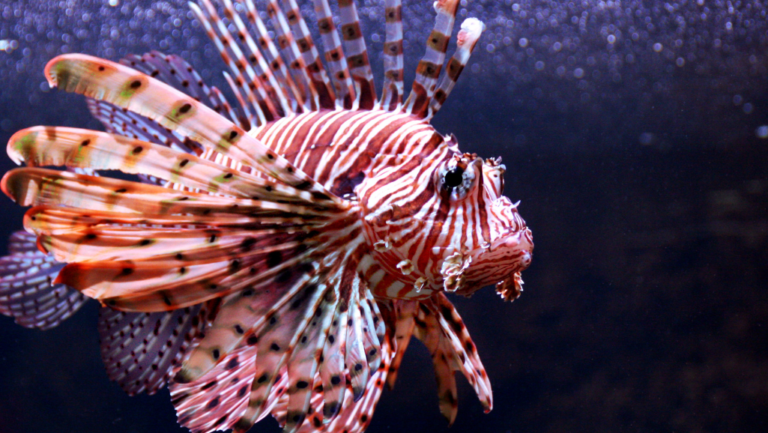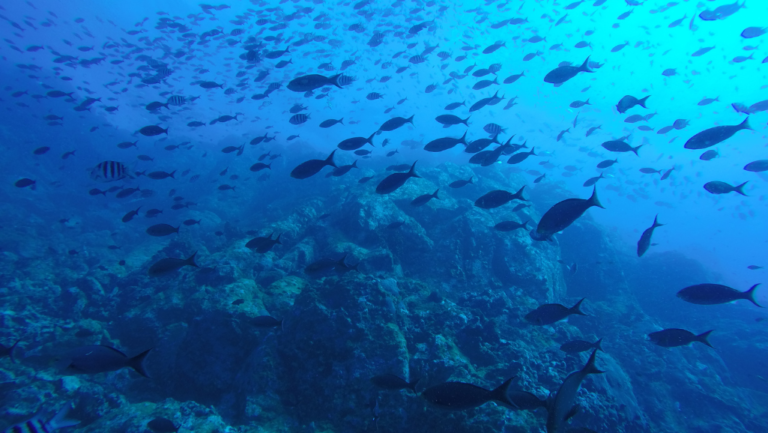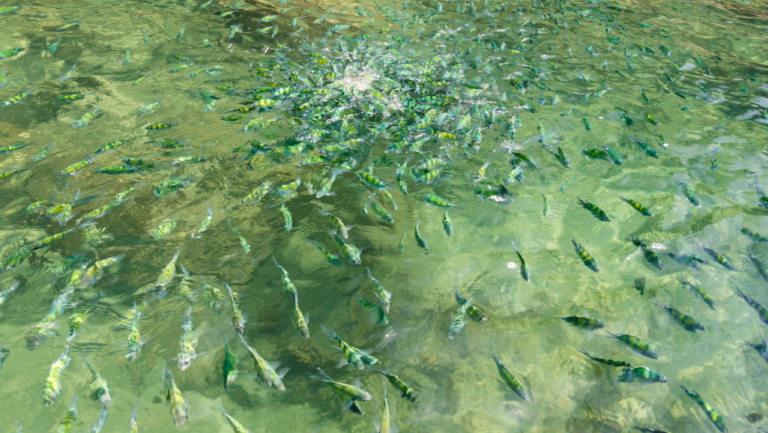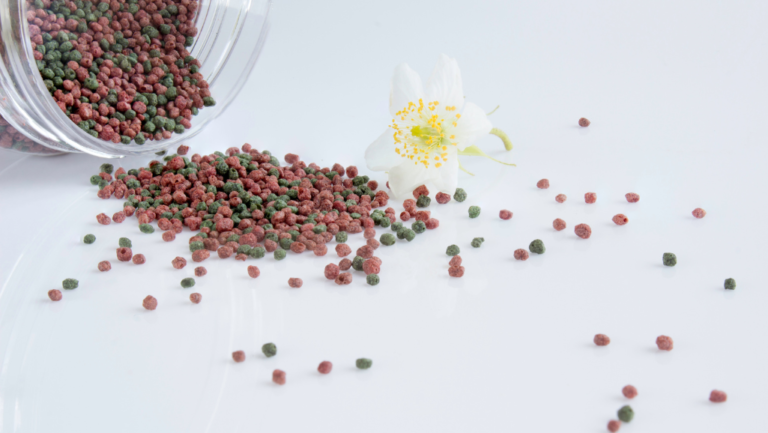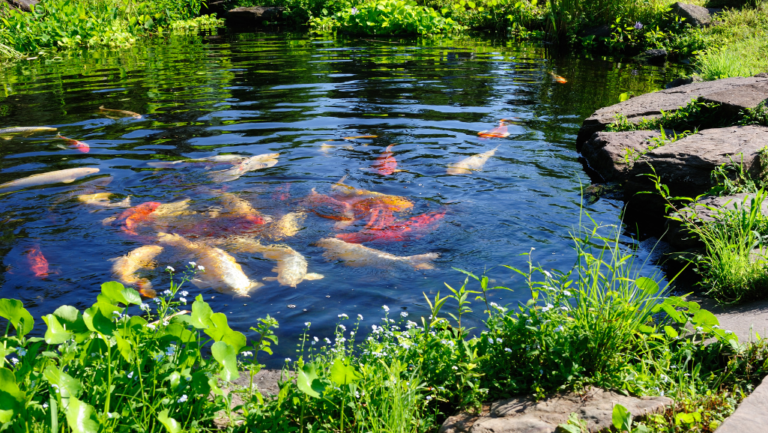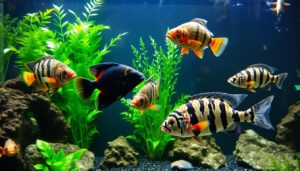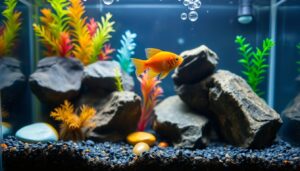Keeping your aquarium pets healthy starts with the right food. With many options, picking the best can be tough. Knowing what your fish need is the first step.
Fish foods come in flakes, pellets, wafers, and freeze-dried types. These cater to different eating habits. A balanced diet should mix these to keep your fish healthy. Adding color-enhancing formulas can make your fish’s colors pop.
Think about what your fish eat naturally. Carnivores, omnivores, and herbivores need different foods. For example, active characins like Pristella Tetra need protein-rich diets. Livebearers, like Guppies, do well with Spirulina and color enhancers.
Good fish food has nutrients from fish meal. But, too much ash (10% or more) means lower quality. This can harm your fish’s health.
Key Takeaways
- Choose fish food based on the specific dietary needs of your fish species
- Provide a varied diet with a mix of flakes, pellets, wafers, and freeze-dried options
- Consider color-enhancing formulas to bring out the vibrant colors of your fish
- Ensure the fish food contains high-quality protein sources and essential nutrients
- Avoid fish foods with excessive ash content, as it may indicate lower quality ingredients
Types of Dry, Prepared Fish Foods
Dry, prepared fish foods are a great choice for your aquarium pets. They come in different forms to meet the needs of various fish species. Flakes are the most common and are available at pet stores. They float and slowly sink, making them suitable for different fish.
Pellets are another popular choice. They come in floating, slow-sinking, and sinking types. This variety is perfect for fish that swim at different levels. They are rich in protein and come in various sizes for different fish.
Wafers and Sticks
Wafers and sticks are great for grazers and larger fish. They dissolve slowly and keep their shape for a long time. Fish sticks are for medium and large fish that eat from the surface. Wafers are best for crustaceans and bottom-feeding fish.
Freeze-Dried Foods
Freeze-dried foods are made from crustacean larvae, insects, and zooplankton. They are processed to keep their nutrients, taste, and smell. These foods are loved by fish keepers for their convenience and nutritional value. They are often loaded with vitamins for extra nutrition.
“Freeze-dried foods offer a convenient and nutritious option for aquarium hobbyists, as they retain the essential nutrients and flavors that fish need to thrive.”
Powdered Foods
Powdered foods are ideal for baby fish, shrimp, and tiny nano fish. They are finely ground for easy digestion. This ensures that even the smallest fish get the nutrients they need to grow.
When picking the best fish food, think about your fish’s needs and how they eat. This will help keep them healthy and happy.
Gel Fish Foods
Gel fish food has become a favorite among aquarium fans, thanks to brands like Repashy Ventures. It’s made by mixing a powder with hot water, creating a gel that lasts up to 24 hours underwater. This food is great for slow eaters and those that graze, as it lets them eat at their own pace.
Gel fish food is very nutritious. Homemade versions can have over 55% protein, making it a top choice for fish. The University of Florida’s recipe includes shrimp, spinach, and gelatin, while Mazuri’s has 56% protein and 15% fat.
Gel food comes in many flavors for different diets. You can also add ingredients like medication or pureed veggies. It’s easy to mix and match ingredients like salmon, shrimp, and gelatin, making it flexible.
To make gel food, mix the powder with hot water and let it set. Then, store it in the fridge. You can freeze it in cubes for longer storage. Feeding is simple: just thaw the cubes slowly in the tank.
Gel food also makes fish colors pop by adding color enhancers like astaxanthin. It’s long-lasting, customizable, and good for many fish species. It’s a great choice for those who want to feed their fish well and easily.
Frozen Fish Foods
Frozen fish foods are a great choice for aquarium owners. They are nutritious and mimic the natural diet of fish. These foods are made from whole ingredients, loaded with nutrients, and then frozen to keep their taste and value.
Frozen foods are good because they sink. This makes them easy for bottom-dwelling fish to eat. They come in all sizes, from tiny brine shrimp to big silversides. This variety meets the needs of many fish species.
Crustaceans like daphnia and brine shrimp are great for fish. Their hard shells help with digestion.
Feeding Frozen Foods
It’s important to think about the size and diet of your fish when feeding frozen foods. Some fish need human-grade seafood, while others, like pufferfish, need crunchy foods to wear down their teeth. Always thaw frozen foods before feeding and give small amounts to avoid overfeeding and keep the water clean.
Variety of Frozen Foods
There are many frozen fish foods available. They cater to the different needs of aquarium fish. Here are some examples:
- Frozen Krill Pacifica blocks (15 kg) priced at $75.00
- Frozen Mysis Flat Packs (10 x 1 kg, totaling 10 kg / 22 lb) priced at $175.00
- Frozen Brine Shrimp flat packs (5 x 2 KG, totaling 10 kg / 22 lbs) priced at $85.45
- Frozen Rotifer flat packs (5 x 1 lb, totaling 5 lb) priced at $42.00
- Frozen Bloodworm flat packs (5 x 500 g, totaling 2.5 kg / 5.5 lbs) priced at $89.00
Adding different frozen foods to your fish’s diet ensures they get all the nutrients they need. This variety helps keep your fish healthy and vibrant.
Live Fish Foods
Feeding live foods to aquarium pets has many benefits. It improves their nutrition, keeps them mentally active, and helps with breeding. Live foods also encourage fish to eat more and provide fun hunting experiences. Plus, they clean up without making a mess.
Common Live Foods
Some favorite live foods for aquarium pets are:
- Blackworms – Rinse well with dechlorinated water at 40–55°F (4–13°C) to avoid overcrowding.
- Mealworms – You can buy them at reptile stores.
- Micro worms – Grindal worms are about 0.5 mm, while white worms are 1 mm.
- Vinegar eels – They’re easy to grow at home.
- Baby brine shrimp – Eggs hatch in 24 hours at 74–82°F (23–28°C) for quick feeding.
Cultivating Live Foods at Home
Many live foods can be grown at home for a steady supply. Grindal and white worms need sterilized substrate, heated for 30 minutes at 180–200°F (82–93°C). They thrive in temperatures of 70–75°F (21–24°C) and 55°F (13°C), respectively. Daphnia need stable, aged, dechlorinated water as they’re sensitive to chlorine. Growing houseflies at home reduces the risk of parasites.
Daphnia are perfect for home hobbyists. They’re easy to culture in a home aquarium and great for almost any Nano fish. They’re also good for fry because of their small size.
To start a Daphnia culture, use a wide container with lots of surface area and shallow water. Add an air stone for oxygen. Keep the GH:KH ratio at 2:1 for pH stability. Use crushed coral to soften the water if needed. Bloodworms, brine shrimp, mosquito larvae, and wingless fruit flies are also popular live foods that can be bred at home.
Specialty Fish Foods
Some aquarium fish need special foods because of their unique diets. These foods give them the nutrients they need to stay healthy and grow well.
Vegetable-Based Foods
Herbivorous fish, like some catfish and cichlids, need lots of plants in their diet. Foods like spirulina wafers or algae tablets are great for them. You can also give them blanched veggies like zucchini or spinach for extra nutrients.
Calcium-Enriched Foods
Fish that need a lot of calcium, like livebearers and African cichlids, do well with calcium-rich foods. These foods help keep their bones strong and support their growth. You can find calcium-enriched pellets or wafers at pet stores.
Wood-Based Foods for Plecos
Plecos, known for eating algae, also need wood in their diet. Wood helps with digestion and gives them fiber. Foods with wood, like vegetarian fish food with wood fiber, meet their needs and keep them healthy.
When picking out specialty fish foods, think about what your fish need. Talk to experts or pet store staff to make sure you choose the right food. A balanced diet tailored to your fish’s needs will help them stay healthy and make your aquarium vibrant.
Choosing the Right Fish Food
Choosing the right fish food is key to keeping your fish healthy. There are many options, so it’s important to pick the right one for your fish. Most fish need a mix of animal and plant-based foods.
It’s important to match the food to your fish’s eating habits. Some fish eat from the bottom, while others prefer the middle or top of the water. Flake foods and microgranules are great for small fish because they’re easy to eat.
Flake foods are popular because they’re affordable and versatile. They suit many fish well.
Consider Nutritional Requirements
Different fish need different foods. Pellet foods come in types like floating and sinking. They’re made to meet the needs of various fish.
Frozen foods are also good because they’re like what fish eat in nature. They’re nutritious because they’re flash-frozen. Live foods are great for enriching your fish’s diet, too.
Match Feeding Habits
There are special foods for certain fish. Some people give their fish human veggies. For fish like livebearers, snails, and shrimp, calcium-enriched pellets are important.
“When it comes to wood-eating catfish, like clown plecos, they may not actually digest the wood itself. Instead, they feed on the microorganisms growing on the wood’s surface. To ensure their optimal health, it’s important to provide them with additional high-fiber foods.”
Choosing the right food is crucial for your fish’s health. Look into products like Bio-Pro Plus Probiotic Health Supplements and Vita-Chem Freshwater. They can help keep your fish happy and healthy.
Conclusion
Choosing the right fish food is key for your aquarium pets’ health. There are many types, like dry, gel, frozen, live, and specialty foods. Each type meets different needs based on your fish’s species.
Flake, pellets, wafers, and freeze-dried foods are easy to use. But, frozen and live foods are better for carnivorous fish. They offer more natural and nutritious options.
When picking fish food, think about your fish’s mouth size, diet, and nutritional needs. Look for foods with the right mix of proteins, fats, carbs, vitamins, and minerals. Special foods like veggie-based, calcium-rich, and wood-based diets meet specific species’ needs.
By offering a variety of high-quality foods and a regular feeding schedule, your fish will stay healthy and lively. This ensures they get all the nutrients they need.
Good aquarium nutrition makes your fish look great and keeps the tank healthy. It’s also important to test the water regularly. Check pH, nitrate, and ammonia levels and fix any problems fast.
By choosing the right food and managing the water well, you’ll have a beautiful and peaceful aquarium. It will add joy and calm to your home or office.


